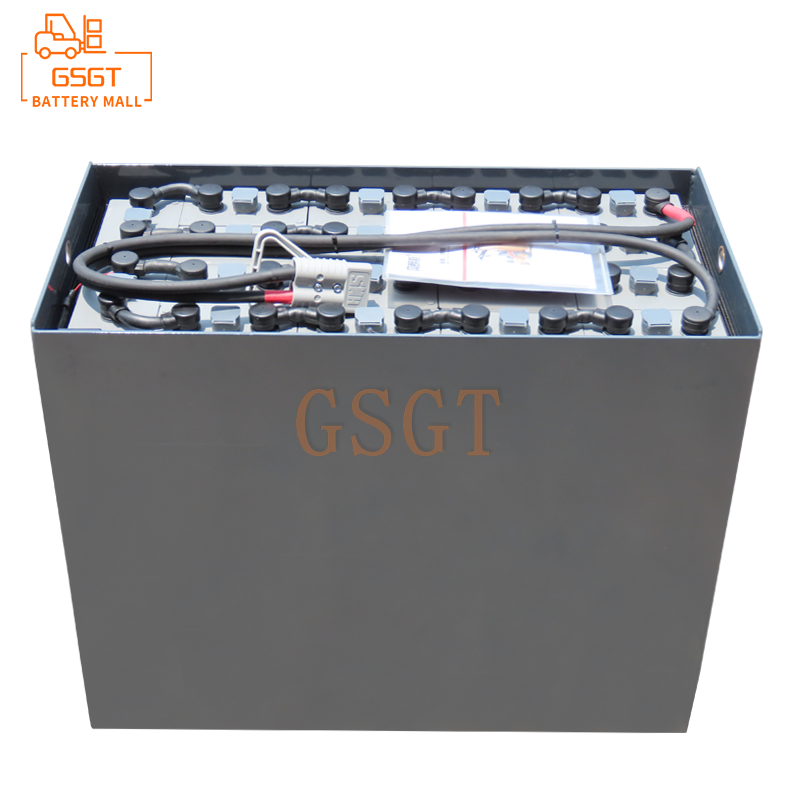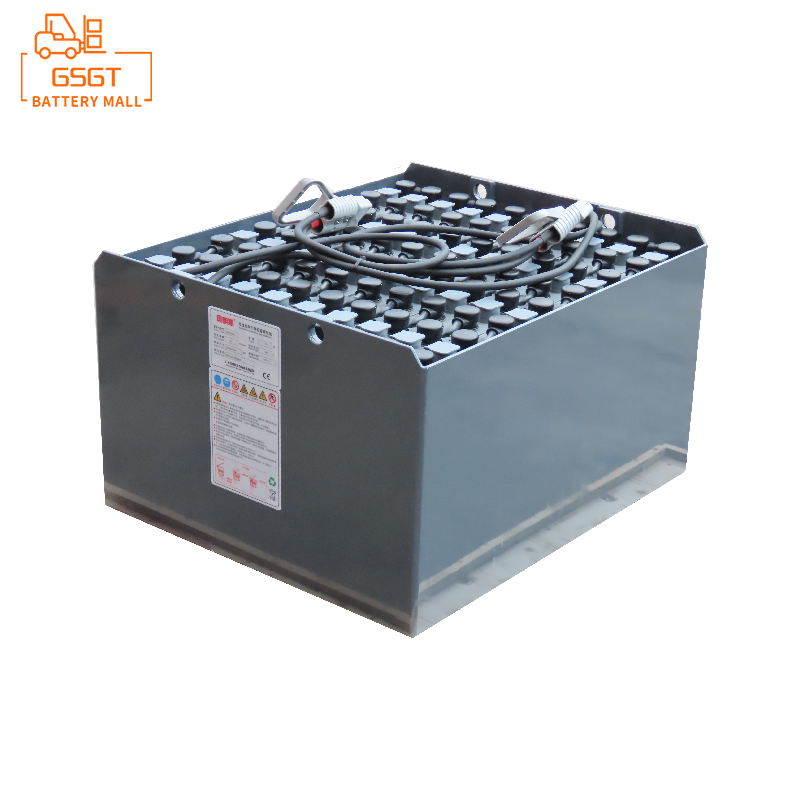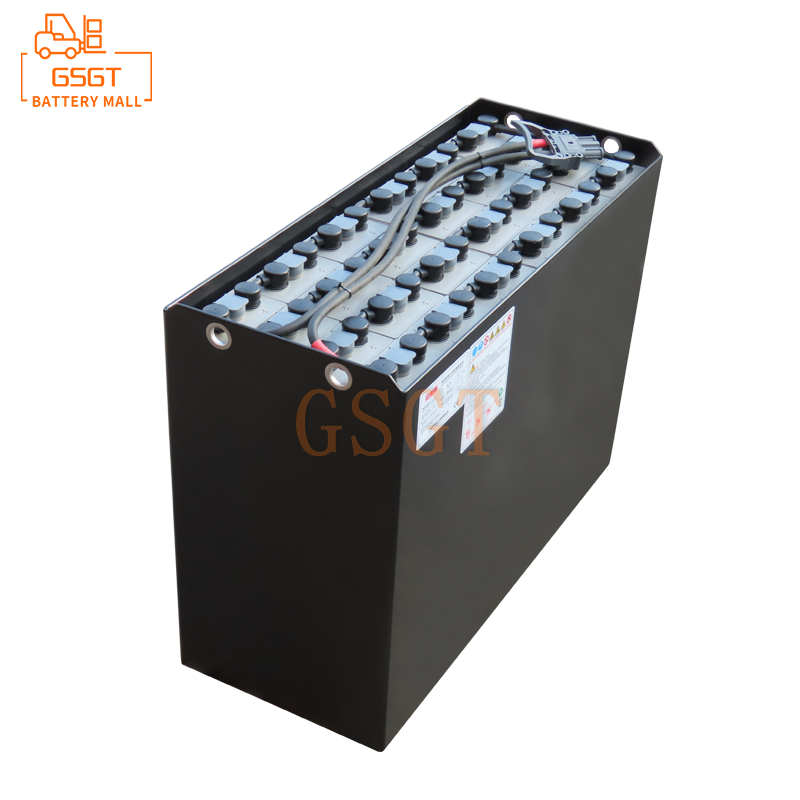Time:2025-07-12 11:40:22
Browse:611
In the daily operation of forklifts, the performance of lead-acid batteries directly affects work efficiency. Sulfation is one of the most common faults of lead-acid batteries. If not dealt with in time, it will lead to a sudden drop in battery capacity, a decline in charging and discharging efficiency, and even premature scrapping. This article will provide a detailed analysis of the causes, preventive measures and treatment methods of sulfation in forklift lead-acid batteries, helping forklift users reduce fault losses and extend the battery's service life.
Ⅰ. What is sulfation of lead-acid batteries?
The core working principle of lead-acid batteries is to achieve charging and discharging through the chemical reaction between the plates and the electrolyte (sulfuric acid solution). Under normal circumstances, loose lead sulfate crystals are formed on the plates during discharge, and these crystals can be reconverted into active substances during charging. However, when the battery is used or maintained improperly, lead sulfate will adhere to the surface of the plates in the form of hard crystals, causing irreversible sulfation.
The harm of sulfidation is significant: lead sulfate crystals on the plates can clog the porous structure, hinder the penetration of the electrolyte, resulting in a significant reduction in battery capacity, prolonged charging time, and a sudden drop in voltage during discharge. In severe cases, the crystals will expand and burst the plates, causing permanent damage. During forklift operations, this may lead to power outages in the middle, affecting logistics efficiency and even causing safety hazards.
Ⅱ. Main Causes of vulcanization
Vulcanization does not occur suddenly but is the result of long-term improper operation accumulation. Understanding the causes is the key to prevention:
1. Charging is not timely or complete
If the forklift is not charged in time after operation, the lead sulfate on the plates will gradually form stable crystals. Especially in low-temperature environments, the crystallization rate accelerates. Some users, in an attempt to save time, stop charging when the battery reaches 80%. If this continues for a long time, lead sulfate will not be fully converted and will accumulate to form sulfidation.
2. Over-discharge
If a forklift is still in use when its battery level is below 20%, it will cause deep discharge of the plates, resulting in an excessively high concentration of lead sulfate and making it difficult for the crystals to decompose. For instance, if a forklift is forcibly discharged when fully loaded while climbing a slope, or if the battery is left idle for a long time after being completely drained, sulfation is likely to occur.
3. Abnormal electrolyte level
When the electrolyte level is lower than the plates, the exposed plates will come into contact with air for oxidation, and at the same time, the concentration of the electrolyte will increase, accelerating the formation of crystals. In addition, adding tap water or excessive electrolyte can also disrupt the internal balance of the battery and induce sulfation.
4. Long-term idleness and environmental impact
If a forklift is not used for more than one month and its power is not replenished regularly, the battery will self-discharge and sulfate. Meanwhile, high temperatures (above 35℃) will accelerate the evaporation of the electrolyte and the corrosion of the plates, while low temperatures (below 5℃) will reduce the charging efficiency and cause residual lead sulfate crystals.
Ⅲ. Preventive Measures for Sulfidation
The core of preventing sulfation is to maintain battery activity and reduce the conditions for the formation of lead sulfate crystals. In light of the characteristics of forklift operations, the following measures can be taken:
Standardize the charging process
Start charging within one hour after the operation is completed to prevent the plates from crystallizing and solidifying. Use the original charger to ensure that the charging voltage matches the battery. After fully charging, float charge for 1-2 hours to ensure that the lead sulfate is completely converted.
In a low-temperature environment, the battery can be left to stand at room temperature (20-25℃) before charging. If necessary, install an insulation device in the charging area to prevent undercharging.
2. Avoid over-discharging and recharge in time
When the forklift dashboard shows that the battery level is below 20%, operation should be stopped immediately and charging resumed. The habit of "recharging when the battery is completely drained" is strictly prohibited. Low battery warning lines can be clearly marked in the forklift operation manual, and operators should be trained to strictly abide by them.
For forklifts that are used intermittently, they should be recharged at least once a day to prevent the accumulation of self-discharge. Before long-term disuse, the battery should be fully charged. After that, it should be recharged every two weeks to keep the battery level between 50% and 80%.
3. Regularly inspect and maintain the electrolyte
Check the electrolyte level every week. If it is 10-15mm lower than the upper edge of the plates, add distilled water (do not use tap water or electrolyte). After adding, let it stand for 30 minutes before charging to avoid uneven concentration.
The density of the electrolyte is tested quarterly (using a hydrometer), with a normal range of 1.28g/cm³ (at 25℃). When the density is too low, it needs to be adjusted through equalization charging.
4. Strengthen daily maintenance and environmental control
Clean the battery surface monthly to remove dust and electrolyte spills and prevent corrosion of the terminal posts. Check if the cable connection is loose to avoid poor contact which may lead to a decrease in charging efficiency.
When storing forklifts, choose a dry and well-ventilated environment, avoiding direct sunlight or proximity to heat sources. If the battery is idle for more than 15 days, the negative terminal should be disconnected to reduce self-discharge loss.
Ⅳ. Treatment Methods for vulcanization
If the battery has sulfated (such as a rapid increase in voltage during charging and a sudden drop in capacity during discharging), the following measures can be taken depending on the severity:
Mild vulcanization: Pulse repair method
For batteries that have been in use for less than half a year and have a relatively light sulfation, a pulse repair instrument can be used for treatment. The principle is to break up lead sulfate crystals through high-frequency pulsed current, converting them back into active substances. When operating, connect the repair instrument to the positive and negative terminals of the battery, set the pulse frequency to 10-20kHz, and continue the repair for 24-48 hours. During this period, check the electrolyte temperature every 6 hours. If it exceeds 45℃, pause for cooling.
2. Moderate sulfidation: Water replenishment and charging method
First, completely discharge the battery, pour out some of the electrolyte (keeping the liquid level covering the plates), add distilled water to the standard liquid level, and let it stand for 2 hours.
Charge with a small current (1/10 of the rated current), stop when the voltage rises to 2.4V per cell, discharge to 1.7V per cell, and repeat 3 to 5 cycles to gradually decompose and crystallize.
3. Severe vulcanization: Professional repair or replacement
If the plates show obvious deformation or fall off, or if the capacity is still less than 50% of the rated value after repair, it indicates that sulfation is irreversible. It is necessary to contact a professional institution to replace the plates or directly replace the battery with a new one. It should be noted that if the cost of repairing a severely sulfated battery exceeds 60% of that of a new battery, it has no repair value.
Ⅴ. Frequently Asked Questions
1. How to quickly determine if a forklift battery has sulfated?
The initial judgment can be made through three phenomena: First, the time it takes for the voltage to rise to 2.7V per cell during charging is more than 50% shorter than that of a new battery. Second, during discharge, the full-load travel distance of the forklift is reduced by more than 30% compared to the normal state. The third is that the electrolyte is turbid and grayish-white (normally transparent and light yellow). If the above situations occur, it is recommended to have them inspected and repaired in a timely manner.
2. Is the pulse repair instrument effective for all sulfurized batteries?
That's not the case. Pulse repair is only effective for loose crystals that have formed within three months. For crystals that have been formed for more than six months and have hardened, its effect is limited. In addition, if the battery has physical damages such as short circuits in the plates or cracked shells and pulse repair cannot solve the problem, the physical faults need to be repaired first.
3. Is it necessary to frequently replenish the electrolyte to prevent sulfidation?
No need. Under normal circumstances, it is sufficient to replenish the battery with distilled water every 3 to 6 months. Excessive water replenishment will dilute the concentration of the electrolyte and reduce the battery capacity. When replenishing, it should be noted that the liquid level must not exceed the scale line; otherwise, the electrolyte may overflow during charging and corrode the forklift components.
Through scientific prevention and timely handling, the sulfation phenomenon of forklift lead-acid batteries can be effectively reduced, and their service life can be extended by more than 30%. The key lies in developing the habit of "timely charging, regular inspection and avoiding over-discharge", and at the same time adjusting the maintenance strategy in combination with the actual working conditions to keep the battery in good condition all the time and ensure the efficient operation of the forklift.

$7660

$2440

$8340

$2610

MESSAGE
Professional And Efficient
Security
Affordable Price
Professional Services